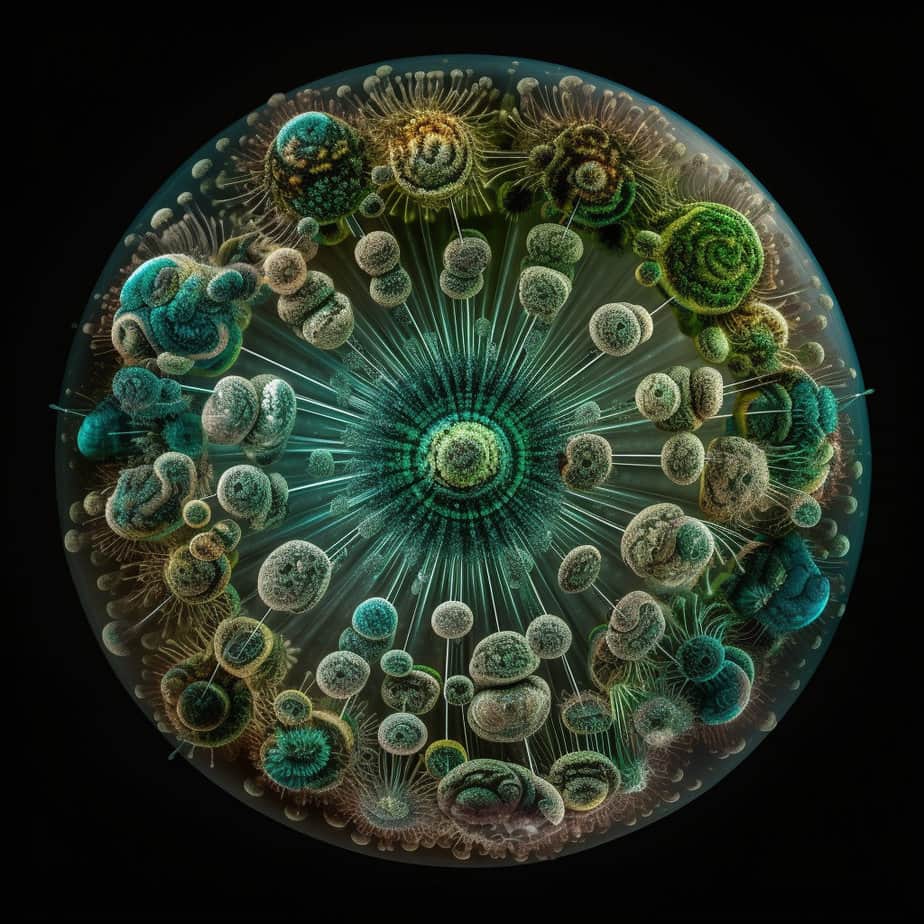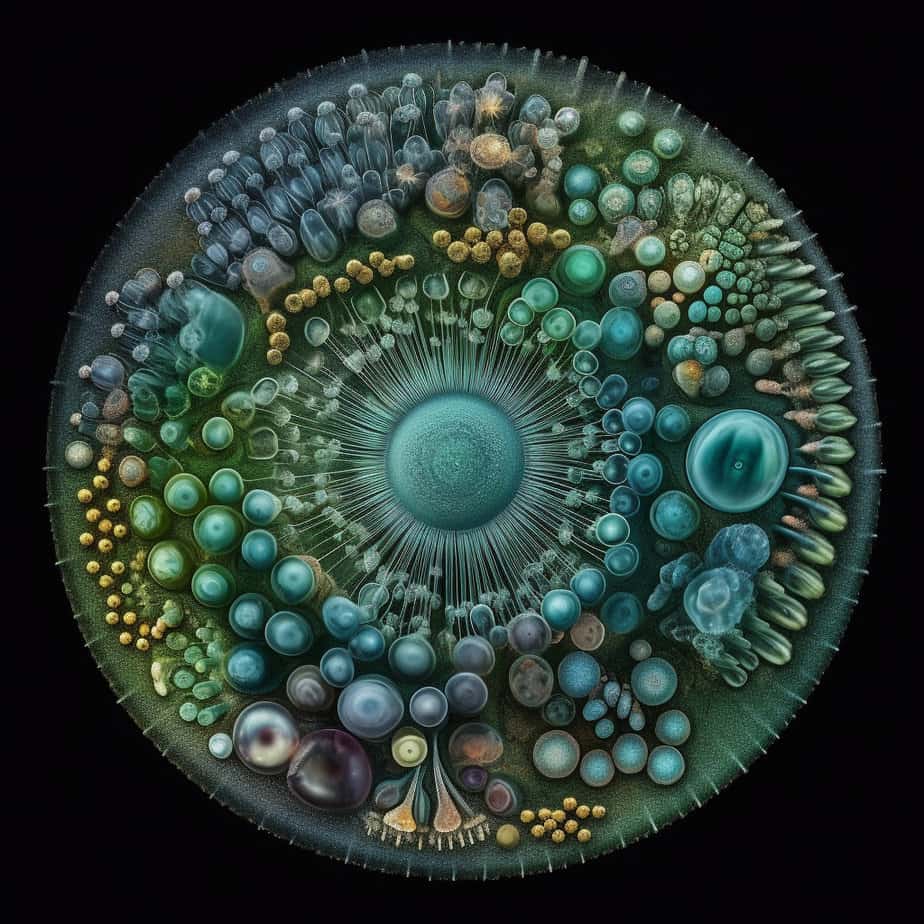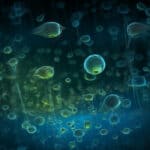Phytoplankton are microscopic organisms that play a crucial role in the Earth’s ecosystems. These tiny plants, which are found in both freshwater and marine environments, are responsible for producing approximately half of the world’s oxygen through photosynthesis. Despite their small size, phytoplankton have a significant impact on the planet‘s climate, carbon cycle, and overall biodiversity. In this article, we will explore the characteristics of phytoplankton, including their diverse forms, adaptations, and ecological importance. We will delve into their role as primary producers, their ability to thrive in various environments, and the factors that influence their growth and distribution. Join us as we uncover the fascinating world of these microscopic organisms and discover why they are vital to the health and balance of our planet.
Key Takeaways
- Phytoplankton are microscopic plants that form the foundation of the marine food chain.
- They are photosynthetic organisms that require sunlight, nutrients, and carbon dioxide to grow.
- Phytoplankton play a crucial role in oxygen production and carbon sequestration.
- They exhibit a wide range of shapes, sizes, and colors, including diatoms, dinoflagellates, and cyanobacteria.
- Environmental factors such as temperature, nutrient availability, and light intensity influence phytoplankton growth and distribution.
- Changes in phytoplankton populations can have significant impacts on marine ecosystems and global climate patterns.
Understanding Phytoplankton: A General Overview

A. Definition and Basic Characteristics of Phytoplankton
Phytoplankton, often referred to as the “grass of the sea,” are microscopic algae that inhabit aquatic ecosystems, ranging from freshwater lakes to vast oceans. These tiny organisms play a crucial role in maintaining the health and balance of marine ecosystems. Let’s delve into the definition and basic characteristics of phytoplankton.
-
Definition: Phytoplankton are photosynthetic organisms that drift in the water column, unable to swim against the currents. They are primary producers, meaning they convert sunlight, carbon dioxide, and nutrients into organic matter through the process of photosynthesis.
-
Size and Structure: Phytoplankton come in various shapes and sizes, ranging from single-celled organisms to colonial forms. They are typically microscopic, measuring between 2 and 200 micrometers. Their size allows them to remain suspended in the water, where they can access sunlight for photosynthesis.
-
Diversity: Phytoplankton encompass a wide range of species, including diatoms, dinoflagellates, and cyanobacteria. Each species has its unique traits and adaptations that enable them to thrive in different environmental conditions.
-
Nutrient Requirements: Like all living organisms, phytoplankton require essential nutrients to survive and grow. These nutrients include nitrogen, phosphorus, and trace elements. The availability of these nutrients in the water column influences the growth and distribution of phytoplankton species.
-
Environmental Factors: Phytoplankton growth is influenced by several environmental factors, including temperature, light penetration, and water movement. Different species have specific temperature and light requirements, which determine their distribution patterns in the ocean. Light availability is particularly crucial for photosynthesis, as phytoplankton rely on sunlight to convert carbon dioxide into organic matter.
-
Role in Ecosystems: Phytoplankton serve as the foundation of the marine food chain. They are consumed by zooplankton, which, in turn, are eaten by larger organisms such as fish and marine mammals. Phytoplankton also play a vital role in nutrient cycling and carbon dioxide absorption, contributing to the overall productivity and health of the oceans.
B. Different Species of Phytoplankton and Their Unique Traits
Phytoplankton encompass a diverse array of species, each with its unique traits and adaptations. Let’s explore some of the most common phytoplankton species and their characteristics:
-
Diatoms: Diatoms are one of the most abundant and diverse groups of phytoplankton. They have a distinctive cell wall made of silica, which gives them a glass-like appearance. Diatoms are known for their intricate geometric shapes and play a crucial role in carbon fixation and oxygen production. They are often found in nutrient-rich coastal areas and are indicators of water quality.
-
Dinoflagellates: Dinoflagellates are another important group of phytoplankton. They possess two flagella, which enable them to move through the water column. Some dinoflagellates are bioluminescent, emitting a mesmerizing glow when disturbed. Certain species of dinoflagellates can cause harmful algal blooms, known as red tides, which can have detrimental effects on marine life and human health.
-
Cyanobacteria: Cyanobacteria, also known as blue-green algae, are photosynthetic bacteria that can perform oxygenic photosynthesis. They are capable of fixing atmospheric nitrogen, making them important contributors to the nitrogen cycle. Cyanobacteria can form colonies or filaments and are often found in freshwater and marine environments.
-
Other Species: Apart from diatoms, dinoflagellates, and cyanobacteria, there are numerous other phytoplankton species, each with its unique characteristics. These include coccolithophores, haptophytes, and green algae. Each species plays a specific role in the marine ecosystem and contributes to the overall diversity and productivity of the oceans.
Understanding the characteristics and diversity of phytoplankton is essential for comprehending the intricate workings of marine ecosystems. These microscopic organisms, through their photosynthetic abilities and ecological roles, have a profound impact on the health and balance of our oceans. By studying phytoplankton, scientists can gain valuable insights into the effects of climate change and human activities on marine environments, enabling us to make informed decisions for the conservation and sustainable management of our precious oceanic resources.
The Physical Characteristics of Phytoplankton
Phytoplankton, the microscopic algae that inhabit aquatic ecosystems, come in a variety of shapes, sizes, and colors. These characteristics play a crucial role in their survival and ecological significance. Let’s explore the physical traits of phytoplankton and their adaptations to thrive in their environment.
A. Size and Shape: The Microscopic World of Phytoplankton
Phytoplankton, being microscopic organisms, range in size from a few micrometers to several hundred micrometers. They are so small that they can only be seen under a microscope. Despite their diminutive size, phytoplankton are the primary producers in the oceanic food chain, providing sustenance for zooplankton and other marine organisms.
The shape of phytoplankton varies greatly among different species. Some phytoplankton, such as diatoms, have intricate and symmetrical shapes, resembling geometric patterns. Others, like cyanobacteria, are more elongated or filamentous in form. These diverse shapes allow phytoplankton to occupy different ecological niches and optimize their exposure to light and nutrient availability.
B. Color Variations and Their Significance
Phytoplankton exhibit a wide range of colors, including green, brown, red, and even blue. These color variations are primarily due to the presence of pigments, such as chlorophyll, which are essential for photosynthesis. Chlorophyll absorbs sunlight and converts it into energy, enabling phytoplankton to produce organic matter and release oxygen into the water.
The color of phytoplankton can also indicate their physiological state and environmental conditions. For example, high chlorophyll concentrations often result in a greenish hue, indicating a phytoplankton bloom. These blooms can have significant ecological consequences, affecting nutrient cycling, ocean productivity, and carbon dioxide absorption.
C. Adaptations: How Phytoplankton Thrive in Their Environment
Phytoplankton have evolved various adaptations to survive and thrive in their aquatic environment. These adaptations allow them to exploit available resources efficiently and withstand environmental fluctuations.
One crucial adaptation is their ability to regulate their buoyancy. By adjusting their internal gas vesicles, phytoplankton can control their position in the water column. This adaptation enables them to optimize light exposure and nutrient uptake, as different depths have varying levels of light penetration and nutrient availability.
Phytoplankton also possess mechanisms to cope with changes in temperature and nutrient availability. Some species can enter a dormant stage, forming cysts or resting spores, which can withstand unfavorable conditions until more favorable conditions arise. This adaptation ensures their survival during periods of low nutrient availability or extreme environmental conditions.
Furthermore, phytoplankton have developed strategies to defend themselves against predation and competition. Some species produce toxins, which deter grazers and give them a competitive advantage. However, certain toxin-producing phytoplankton can cause harmful algal blooms, leading to detrimental effects on water quality and marine organisms.
In conclusion, the physical characteristics of phytoplankton, including their size, shape, and color, play a vital role in their ecological significance. These characteristics enable them to occupy different ecological niches, optimize their exposure to light and nutrients, and adapt to changing environmental conditions. Understanding these physical traits is crucial for comprehending the dynamics of marine ecosystems and the impact of climate change on phytoplankton populations.
The Ecological Role of Phytoplankton

Phytoplankton, the microscopic algae that inhabit aquatic ecosystems, play a crucial role in maintaining the health and balance of marine environments. These primary producers are responsible for a significant portion of the Earth’s oxygen production and serve as the foundation of the marine food chain. Let’s explore the ecological role of phytoplankton in more detail.
A. Phytoplankton’s Position in the Food Chain
Phytoplankton occupy a vital position in the marine food chain. As primary producers, they convert sunlight, carbon dioxide, and nutrients into organic matter through the process of photosynthesis. This organic matter, in the form of microscopic algae, serves as a source of food for a wide range of planktonic organisms, including zooplankton.
Zooplankton, such as krill and copepods, feed on phytoplankton, transferring the energy stored in the algae to higher trophic levels. These zooplankton, in turn, become prey for larger organisms like fish, whales, and other marine predators. Thus, phytoplankton form the base of the marine food web, supporting the entire oceanic biota.
B. The Importance of Phytoplankton to Marine Ecosystems
The presence of phytoplankton is crucial for the overall health and stability of marine ecosystems. Their ability to photosynthesize and convert carbon dioxide into oxygen helps regulate the Earth’s atmospheric composition. In fact, phytoplankton are responsible for approximately 50% of the oxygen we breathe, making them a vital component of the global oxygen cycle.
Furthermore, phytoplankton play a significant role in nutrient cycling within the ocean. They absorb nutrients, such as nitrogen and phosphorus, from the water, incorporating them into their cells. When phytoplankton die or are consumed by other organisms, these nutrients are released back into the water, fueling the growth of other marine organisms. This nutrient recycling process is essential for sustaining the productivity and biodiversity of marine ecosystems.
C. How Phytoplankton Affects Water Quality
Phytoplankton also have a direct impact on water quality. Their abundance and diversity influence factors such as water clarity, color, and nutrient availability. High concentrations of phytoplankton can lead to the formation of phytoplankton blooms, which can have both positive and negative effects on water quality.
In some cases, phytoplankton blooms can be beneficial, as they provide a rich food source for marine organisms. However, excessive blooms can lead to harmful algal blooms (HABs), which can have detrimental effects on marine life and human health. Certain species of phytoplankton produce toxins that can accumulate in shellfish and fish, posing a risk to both aquatic organisms and humans who consume them.
Additionally, phytoplankton blooms can alter water clarity by reducing light penetration. This can negatively impact seagrass beds and coral reefs, as these organisms rely on sunlight for photosynthesis. Changes in water quality caused by phytoplankton blooms can disrupt the delicate balance of marine ecosystems and have cascading effects on the entire food web.
In conclusion, phytoplankton are not only fascinating microscopic organisms but also essential components of aquatic ecosystems. Their position at the base of the food chain, their role in oxygen production, nutrient cycling, and their impact on water quality highlight their ecological significance. Understanding the characteristics and dynamics of phytoplankton is crucial for managing and preserving the health of our oceans in the face of climate change and other environmental challenges.
The Distribution of Phytoplankton in the Ocean

Phytoplankton, the microscopic algae that form the foundation of marine food chains, are found throughout the world’s oceans. These tiny organisms play a crucial role in maintaining the health and productivity of aquatic ecosystems. In this section, we will explore where phytoplankton live within the ocean and the factors that influence their distribution.
A. Where Phytoplankton Live: From Surface to Depths
Phytoplankton can be found in various depths of the ocean, from the sunlit surface waters to the dark depths below. The distribution of phytoplankton is primarily determined by two key factors: light penetration and nutrient availability.
-
Surface Waters: The majority of phytoplankton reside in the sunlit surface waters of the ocean. Here, they have access to abundant sunlight, which is essential for photosynthesis, their primary means of energy production. Sunlight provides the necessary energy for phytoplankton to convert carbon dioxide into organic matter, releasing oxygen in the process. This process is crucial for the health of our planet, as it helps regulate the Earth’s climate by absorbing carbon dioxide.
-
Deep Waters: While phytoplankton are most abundant near the surface, they can also be found in deeper waters. In these regions, light penetration is limited, and phytoplankton must adapt to survive under low light conditions. Some species, such as diatoms, have unique adaptations that allow them to thrive in deeper waters. Diatoms, for example, have a glass-like shell that helps them sink and access nutrients from the deeper layers of the ocean.
B. Factors Influencing Phytoplankton Distribution
The distribution of phytoplankton is not solely determined by light availability. Nutrient availability also plays a crucial role in shaping their distribution patterns. Here are some key factors that influence phytoplankton distribution:
-
Nutrient Availability: Phytoplankton require essential nutrients, such as nitrogen, phosphorus, and iron, to grow and reproduce. These nutrients are often found in higher concentrations in upwelling zones, where cold, nutrient-rich waters rise to the surface. Upwelling zones are known for their high phytoplankton productivity and support diverse marine ecosystems.
-
Ocean Temperature: Phytoplankton are sensitive to changes in water temperature. Warmer waters can limit their growth and productivity, while cooler waters can enhance their abundance. Climate change is altering ocean temperatures, which can have significant impacts on phytoplankton distribution and the overall health of marine ecosystems.
-
Water Movement: Ocean currents and water movement can transport phytoplankton across vast distances. This movement can result in the formation of phytoplankton blooms, where large concentrations of these microscopic algae accumulate in specific areas. Phytoplankton blooms can have both positive and negative impacts on marine ecosystems, depending on the species involved and the duration of the bloom.
Understanding the distribution of phytoplankton is crucial for studying the health and productivity of our oceans. These microscopic organisms play a vital role in nutrient cycling, carbon dioxide absorption, and supporting the diverse array of life in marine ecosystems. By studying the factors that influence their distribution, scientists can gain valuable insights into the impacts of climate change and other environmental factors on these essential primary producers.
The Importance of Phytoplankton: Beyond the Ocean
A. Phytoplankton’s Role in Climate Regulation
Phytoplankton, the microscopic algae that inhabit aquatic ecosystems, play a crucial role in regulating the Earth’s climate. These tiny organisms, which are primary producers, are responsible for approximately half of the world’s oxygen production through photosynthesis. They also absorb significant amounts of carbon dioxide, a greenhouse gas that contributes to global warming.
Phytoplankton’s ability to absorb carbon dioxide is vital for maintaining a balance in the Earth’s atmosphere. As carbon dioxide levels increase due to human activities, such as burning fossil fuels, phytoplankton help mitigate the effects of climate change by absorbing and storing carbon. This process, known as carbon sequestration, helps to reduce the amount of carbon dioxide in the atmosphere, thus slowing down the rate of global warming.
Furthermore, phytoplankton also influence climate through their impact on cloud formation. When phytoplankton release certain compounds into the atmosphere, they can act as cloud condensation nuclei, which are essential for cloud formation. Clouds play a crucial role in reflecting sunlight back into space, thereby cooling the Earth’s surface. By promoting cloud formation, phytoplankton indirectly contribute to regulating the planet‘s temperature.
B. Phytoplankton and Human Health: A Surprising Connection
While phytoplankton primarily reside in the ocean, their impact extends beyond marine ecosystems and directly affects human health. One of the most significant connections between phytoplankton and human well-being lies in the production of a compound called dimethylsulfoniopropionate (DMSP). When phytoplankton release DMSP into the water, it undergoes a series of chemical reactions that ultimately lead to the formation of dimethyl sulfide (DMS).
DMS is responsible for the distinct smell often associated with the ocean. However, its significance goes beyond a pleasant aroma. DMS released by phytoplankton has been found to have a direct impact on the Earth’s climate. It acts as a precursor to the formation of aerosols, tiny particles that can influence cloud formation and, consequently, the planet‘s temperature regulation.
In addition to their role in climate regulation, phytoplankton also have a direct impact on human health through the production of harmful algal blooms (HABs). Certain species of phytoplankton, such as dinoflagellates and diatoms, can undergo rapid population growth under specific conditions, leading to the formation of HABs. These blooms can produce toxins that contaminate seafood, posing a risk to human health if consumed.
Furthermore, HABs can deplete oxygen levels in the water, leading to the formation of “dead zones” where marine life struggles to survive. These events can have severe consequences for both the environment and the economy, as they can result in fish kills and the collapse of fisheries.
In conclusion, while phytoplankton may be small and often overlooked, their impact on the planet is immense. From their role in climate regulation through carbon sequestration and cloud formation to their connection to human health through the production of DMS and the occurrence of harmful algal blooms, phytoplankton play a vital role in maintaining the delicate balance of our planet’s ecosystems. Understanding and protecting these microscopic organisms is crucial for the well-being of both the oceans and humanity as a whole. Conclusion
In conclusion, phytoplankton are microscopic organisms that play a crucial role in the Earth’s ecosystems. They are characterized by their ability to photosynthesize, their diverse shapes and sizes, and their adaptation to various environmental conditions. Phytoplankton are the primary producers in aquatic ecosystems, providing food and oxygen for other organisms. They also contribute to the global carbon cycle by absorbing carbon dioxide from the atmosphere. Understanding the characteristics of phytoplankton is essential for studying and managing marine ecosystems, as well as for assessing the impacts of climate change. By studying these fascinating organisms, scientists can gain valuable insights into the health and dynamics of our oceans. So next time you gaze out at the vast expanse of water, remember that beneath the surface, a world of microscopic wonders is thriving, sustaining life as we know it.
Frequently Asked Questions
What are the characteristics of phytoplankton?
Phytoplankton are microscopic algae and planktonic organisms that live in aquatic ecosystems. They are primary producers, meaning they generate their own food through photosynthesis. They have a high chlorophyll concentration, which aids in this process. Phytoplankton species are diverse, including diatoms and cyanobacteria, among others.
What are the 4 characteristics of phytoplankton?
Four key characteristics of phytoplankton include: 1. They are microscopic and float in the water column. 2. They have the ability to photosynthesize, converting sunlight into energy. 3. They are primary producers, forming the base of the marine food chain. 4. They contribute to nutrient cycling and ocean productivity.
What characteristics do you think help the phytoplankton live in this environment?
Phytoplankton have several adaptations that help them survive in their environment. They are buoyant, which allows them to float near the surface of the water where light penetration is optimal for photosynthesis. They also have a high surface area to volume ratio, which aids in nutrient absorption. Their ability to reproduce quickly helps them take advantage of nutrient-rich conditions, leading to phytoplankton blooms.
What term is characteristic of phytoplankton?
The term “primary producers” is characteristic of phytoplankton. This refers to their ability to convert sunlight into energy through photosynthesis, forming the base of the marine food chain.
What are the physical characteristics of phytoplankton?
Phytoplankton are microscopic organisms that float in the water column. They contain chlorophyll for photosynthesis, which gives them a green color. Their shapes and sizes are diverse, ranging from single-celled organisms to complex colonies.
What are the characteristics of phytoplankton species?
Phytoplankton species are diverse and have various characteristics. Diatoms, for instance, have silica cell walls and are known for their unique geometric shapes. Cyanobacteria, on the other hand, are a type of bacteria that obtain their energy through photosynthesis.
Why is phytoplankton important?
Phytoplankton play a crucial role in marine ecosystems. They are primary producers, forming the base of the marine food chain. They also contribute to nutrient cycling and ocean productivity. Additionally, through photosynthesis, they absorb carbon dioxide, playing a significant role in mitigating climate change.
Where is phytoplankton found in the ocean?
Phytoplankton are found throughout the world’s oceans, predominantly in the upper sunlit layer, known as the euphotic zone. This is where light penetration is sufficient for photosynthesis to occur. Their distribution is influenced by factors such as ocean temperature, light availability, and nutrient concentrations.
How does phytoplankton affect water quality?
Phytoplankton can significantly affect water quality. In moderate amounts, they are beneficial, contributing to oxygen production and nutrient cycling. However, excessive growth or phytoplankton blooms, often caused by nutrient pollution, can deplete oxygen levels in the water, leading to the death of other marine life. Some species can also produce toxins, leading to harmful algal blooms.
Where is phytoplankton in the food chain?
Phytoplankton occupy the base of the marine food chain. They are primary producers, converting sunlight into energy through photosynthesis. This energy is then transferred up the food chain when phytoplankton are consumed by zooplankton, small fish, and other marine organisms.




